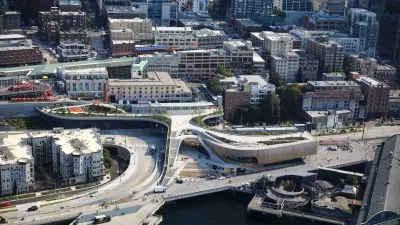Last week, landscape architect James Corner presented a transformative vision for remaking Seattle's waterfront after the removal of the Alaskan Way Viaduct. Lynn Thompson describes Corner's plan, and its accompanying funding challenges.
A heated saltwater swimming pool on a barge? A seasonal roller rink on a pier? A mist machine? Sign us up for a visit to Seattle's waterfront of the future, as presented last week in the latest iteration of a plan by James Corner Field Operations, refined after months of public consultation. Other elements of the plan include parks, pathways and public plazas intended to provide increased public access to the waterfront year-round.
Compared favorably to, "two of Seattle's major civic
undertakings - the 1962 World's Fair and the Forward Thrust initiative
in the late 1960s that built the Kingdome, cleaned up Lake Washington
and built dozens of public swimming pools and community centers," Corner's plan is being enthusiastically endorsed by the city's Central Waterfront Committee.
Now about that $420 million price tag, which the Waterfront Committee's finance subcommittee believes, "half of which would come from a local improvement district funded by
downtown property owners, with the rest from city taxpayers and private
donors," writes Thompson.
"Members of the finance committee said their funding plan is both realistic and achievable."
"We went into this worrying about the scale," said Gerry Johnson, a
Seattle attorney and co-chairman. "We've emerged being very confident
that this is something we can accomplish."
FULL STORY: After the Alaskan Way Viaduct, city sees 'a waterfront for all'

Study: Maui’s Plan to Convert Vacation Rentals to Long-Term Housing Could Cause Nearly $1 Billion Economic Loss
The plan would reduce visitor accommodation by 25,% resulting in 1,900 jobs lost.

North Texas Transit Leaders Tout Benefits of TOD for Growing Region
At a summit focused on transit-oriented development, policymakers discussed how North Texas’ expanded light rail system can serve as a tool for economic growth.

Why Should We Subsidize Public Transportation?
Many public transit agencies face financial stress due to rising costs, declining fare revenue, and declining subsidies. Transit advocates must provide a strong business case for increasing public transit funding.

How to Make US Trains Faster
Changes to boarding platforms and a switch to electric trains could improve U.S. passenger rail service without the added cost of high-speed rail.

Columbia’s Revitalized ‘Loop’ Is a Hub for Local Entrepreneurs
A focus on small businesses is helping a commercial corridor in Columbia, Missouri thrive.

Invasive Insect Threatens Minnesota’s Ash Forests
The Emerald Ash Borer is a rapidly spreading invasive pest threatening Minnesota’s ash trees, and homeowners are encouraged to plant diverse replacement species, avoid moving ash firewood, and monitor for signs of infestation.
Urban Design for Planners 1: Software Tools
This six-course series explores essential urban design concepts using open source software and equips planners with the tools they need to participate fully in the urban design process.
Planning for Universal Design
Learn the tools for implementing Universal Design in planning regulations.
City of Santa Clarita
Ascent Environmental
Institute for Housing and Urban Development Studies (IHS)
City of Grandview
Harvard GSD Executive Education
Toledo-Lucas County Plan Commissions
Salt Lake City
NYU Wagner Graduate School of Public Service



























